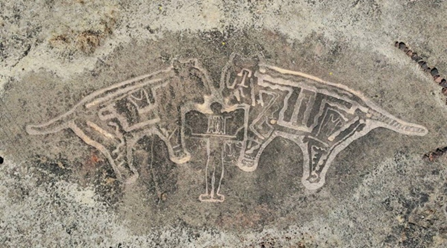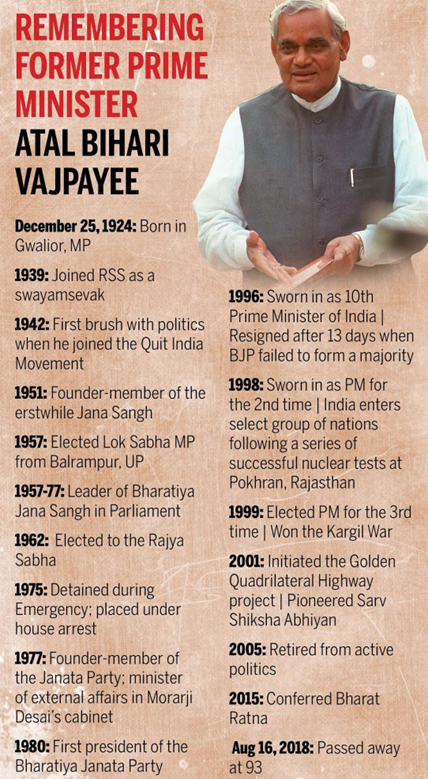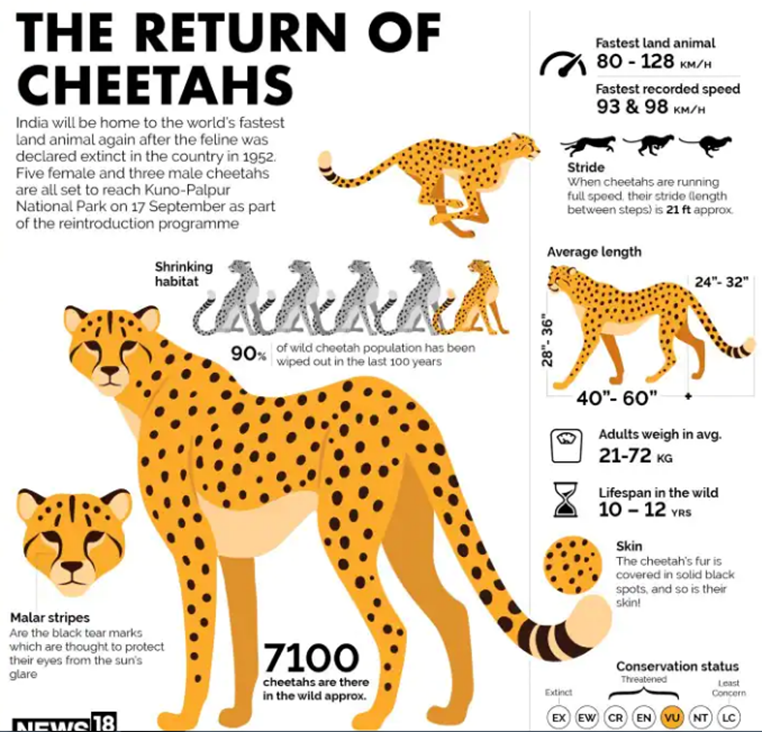Tuesday, 27th December 2022
India’s economy in 2023: Hope & Challenges
In News
India, despite being bracketed with the better-performing economies in 2022, is facing manufacturing unevenness and consumption anomaly. The challenging global environment due to COVID-19, the Russia-Ukraine war and surging food and fuel prices have further clouded the 2023 outlook for India.
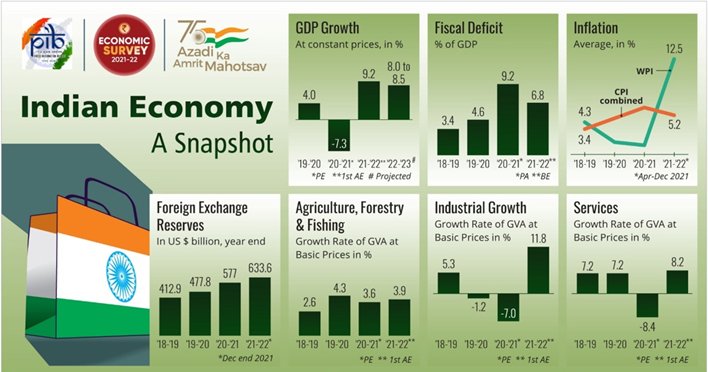
About India’s growth prospects.
- India entered the pandemic after eight successive quarters of declining growth and a flare-up in the inflation trajectory.
- RBI also warned about the darkening global outlook and higher vulnerability of emerging economies.
- The year has witnessed the highest global inflation in 50 years, the most aggressive monetary tightening cycle in nearly 40 years, the strongest US dollar in 20 years, and the weakest Chinese growth in over 45 years.
- The problem going into 2023 is the implications of stubbornly high inflation for the US Federal Reserve, especially after minimal impact on the monetary tightening on inflation.
What could be the impact of an extended phase of rate hikes in the US?
- Unattractive emerging markets: The difference between interest rates in the US and emerging countries like India widens every time the Fed raises policy rates, making the latter less attractive
- Investment outflow: Higher returns in US debt markets could trigger the outflow of investments from emerging market equities.
- Impact on the currency market by the outflow of funds to the US
- Subdued global growth: Sustained rate hikes by the Fed would also mean a lower impetus to growth in the US, which could lead to poor global growth, especially when China is facing a new Covid outbreak.
What are the positive prospects for India in 2023?
- The buoyant near-term growth outlook for India is supported by domestic drivers and reflected in the buoyant trends in high-frequency indicators.
- Moderation of Headline consumer-level inflation, driven by a fall in vegetable prices.
- Mending of twin balance sheet problems e. corporates having high levels of debt and banks saddled with bad loans on their books.
- Increased investments as bank credit have been growing in double digits for eight months now.
- The upturn in the Capex cycle was heralded by waning input cost pressures, surging corporate sales, and a turn-up in investments in fixed assets.
- The China-plus-one strategy which is being adopted by many multinational companies could be an opportunity for India to grab the space in low-skilled, unskilled labour-intensive manufacturing such as textiles, shoes, leather etc.
- Robust direct taxes and GST collections reflect sustained recovery of the corporate sector.
- Agriculture has been a sustained driver for overall GDP growth, with the rabi outlook showing good prospects for wheat production
What challenges does the Indian economy face going forward in 2023?
- Risky external environment such as the Ukraine war, US inflation and subdued global growth affects the Indian economy.
- Higher protectionism worldwide with greater fervour for de-globalization, and economic balkanization could hurt India’s exports.
- Anomalous Private consumption which is growing at over 9% even as manufacturing has shrunk by over 4% can be explained by falling exports and consumption growth being driven by the upper-income groups whose.
- Continuing distress among MSME firms reflects the deep cleavages in industrial recovery where the bigger companies are doing far better than the smaller firms.
- Weak Capital expenditure of states is another concern as investments by states tend to have a higher multiplier effect.
- India’s dependence on imported energy, at 4% of the country’s GDP, is a challenge that shows up on the balance of payments side.
- Inflationary pressure continues despite a hike of 225 bps by RBI.
Source:
https://indianexpress.com/article/explained/explained-economics/hope-challenges-and-a-lot-of-uncertainty-8345533/
Image Source:
https://static.pib.gov.in/WriteReadData/Infographics/2022/Jan/I202201311631.JPG
Smuggling in India - Edukemy Current Affairs
In news
The Union Minister for Finance released the “Smuggling in India Report 2021-22” which analyses trends such as the Smuggling of Gold, Narcotics Drugs and Psychotropic Substances, wildlife, Commercial fraud and International enforcement operations & cooperation.
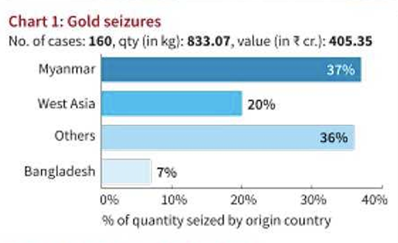 About the report
About the report
- The COVID-19 pandemic has forced smugglers and contraband traffickers to swiftly adapt to the dynamics of changing circumstances and hence have started using novel habitual ways of operations.
- Gold: India is the world's second-largest consumer of Gold after China.
- During 2020-2022, the quantum of smuggling has gone up, as economic activities were opened after the pandemic lockdown.
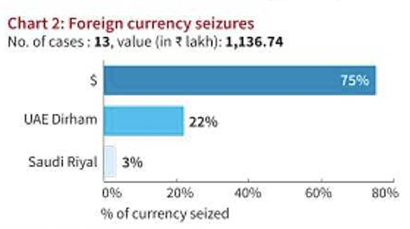
- Foreign currency: Report says that physical smuggling of foreign currency has been chosen as a recourse for those wishing to move liquid value across borders, without detection.
- Cigarettes: High incidence of tax on cigarettes in India results in tax arbitrage in favour of smuggled ones, on which no taxes are paid.
- Narcotics: Increasing number of cases were detected through the cargo route, due to the breakdown of passenger traffic during the Pandemic and also due to recent political changes in Afghanistan.
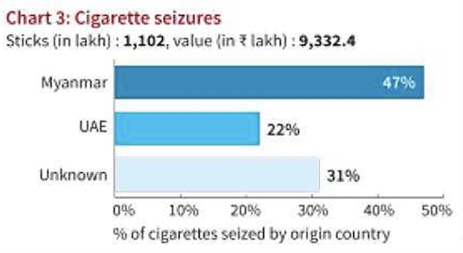
- Red Sanders: High demand and price in the international market is the main cause for illegal felling and smuggling of red sanders.
Laws related to Smuggling in India
- Customs act 1962
- Conservation of Foreign Exchange and Prevention of Smuggling Activities Act, 1974
Measure needed to combat smuggling
- Enacting legislation and plugging the loopholes in the current ones.
- Ensuring physical security of the borders and coasts.
- Eliciting cooperation from neighbours.
- Co-operating with voluntary organisations in the national endeavour to prevent smuggling.
Source
DRI seized 833 kg smuggled gold worth ₹405 cr in FY22: Report
Geoglyphs: Ratnagiri’s pre-historic rock art
Why in news?
- Recently, experts and conservationists have raised concerns over the proposed location for a mega oil refinery in Barsu village of Maharashtra’s Ratnagiri district. They claim that the refinery might damage prehistoric geoglyphs found in the area.
|
About Geoglyphs
|
Background
- The rock art classified as protected monuments by State Archaeology Department and the Archaeological Survey of India is estimated to be 20,000 years old and is prone to damages by the oil refinery project proposed in Ratnagiri district of Maharashtra.
- Although some of these petroglyphs were known to the locals as cultural artefacts left by their ancestors, many sites were only first discovered in 2012.
- These Konkan petroglyphs have now been added to the list of potential UNESCO World Heritage Sites.
Significance of Ratnagiri’s prehistoric art
Location
- Ratnagiri district has more than 1,500 pieces of such art, also called “Katal shilpa,” spread across 70 sites.
Recognised in UNESCO World Heritage List:
- UNESCO’s tentative world heritage list mentions seven sites with petroglyphs in Ratnagiri district: Ukshi, Jambharun, Kasheli, Rundhe Tali, Devihsol, Barsu and Devache Gothane, one in Sindhudurg district –Kudopi village, and nine sites at Phansamal in Goa.
Oldest Material Evidence:
- According to UNESCO, “rock art in India is one of oldest material evidence of the country’s early human creativity.”
- Ratnagiri’s rock art is evidence of the continued existence of human settlements from the Mesolithic (middle stone age) to the early historic era.
- The geoglyphs also show the existence of certain types of fauna that are no longer present in the region today.
Important for Tourism Sector:
- Ratnagiri’s prehistoric sites are among three Indian attractions that may soon become World Heritage Sites.
- The other two include Jingkieng Jri, the living root bridge in Meghalaya, and Sri Veerabhadra Temple in Andhra Pradesh’s Lepakshi.
Concern
- The project is being developed by Ratnagiri Refinery & Petrochemicals Limited, a joint venture of Indian Oil Corporation Ltd, Bharat Petroleum Corporation Ltd and Hindustan Petroleum Corporation Ltd, known as Ratnagiri oil refinery and petrochemical complex.
- The petrochemical refinery will be built in an area identified with more than 250 petroglyphs.
- If the project at Barsu gets started, the rock carvings will get destroyed due to construction and chemical reaction at the site.
Suggestions
- By moving the project 5–6 km away from the sites, the petroglyphs can be preserved.
- The state government of Maharashtra intends to develop an initiative to preserve all petroglyphs in the Konkan region and have their carbon and geological dating done.
Content Source Link:
https://indianexpress.com/article/explained/explained-culture/ratnagiri-geoglyphs-8344954/
Unprecedented ‘bomb cyclone’ - Edukemy Current Affairs
In News:
- US and Canada face havoc post the unprecedented snowstorms
About the News:
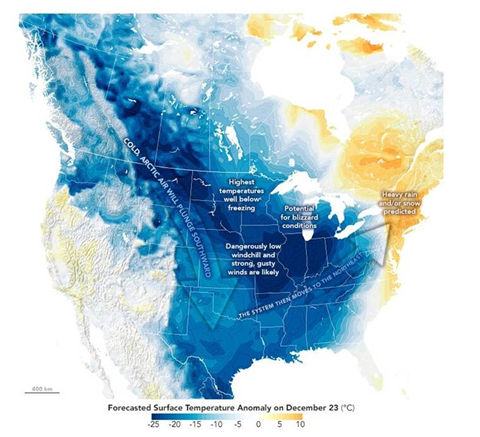
- An intense blizzard or snowstorm has recently wreaked havoc across the United States and Canada killing people and resulting in power outages.
- The severe climatic condition has impacted travel and tourism around the world, especially in these two countries as families come together to celebrate the holiday season.
- As per NASA, the blast of Arctic air is expected to plunge south and help trigger a powerful blizzard that will churn through the central and eastern US.
- Previously, the fiercest winter storm to hit the USA was in 1977 when an intense blizzard killed many people and brought havoc to thousands of households.
Bomb cyclone:
- About: Bomb cyclone or bombogenesis, is a quickly intensifying storm that occurs when air pressure drops 20 millibars or more within 24 hours.
- Formation: Storms can form when a mass of low-pressure air meets a high-pressure mass resulting in air flows from high pressure to low, creating winds.
- Condition: It usually happens when a warm air mass collides with a cold one, for example, air from the Arctic ploughed into tropical air from the Gulf of Mexico, forming a depression bringing rain and snow.
- Direction: As the winds blow, the rotation of the Earth creates a cyclonic effect with the direction of the cyclone as counter-clockwise in the Northern Hemisphere when viewed from above.
- Impact: The triggered storm in such conditions often sparks a "polar vortex plunge" where a particularly cold air mass from the Arctic heads south toward the lower, warmer latitudes.
- Temperature: Combined with blizzards and snow, the wind chill during bomb cyclones can make it feel like minus 55 degrees.
- Health: Exposure to such cold can lead to frostbite on exposed skin within a matter of minutes, hypothermia and even death if exposed to these conditions for too long.
- Spread: As the Arctic air spreads over a wider area, it eventually turns warm, reducing the pressure difference and the storm dissipates.
Source:
https://indianexpress.com/article/explained/explained-climate/what-is-a-bomb-cyclone-an-intense-blizzard-currently-sweeping-across-the-us-8345285/
PRASAD Scheme - Edukemy Current Affairs
- Context: Recently President inaugurated the ‘PRASAD’ project to create a slew of facilities at Srisailam.
|
Srisailam 1. Deity: Mallikarjuna Swamy 2. Dedicated to Shiva and Parvati 3. Location: Nallamalla Hills, Andhra Pradesh 4. Tribe: Chenchu Tribe 5. Architecture: the Dravidian style
|
- The ‘National Mission on Pilgrimage Rejuvenation and Spiritual Augmentation Drive’ (PRASAD) was launched by the Ministry of Tourism in the year 2014-15 with the objective of holistic development of identified pilgrimage destinations.
- The name of the scheme was changed from PRASAD to “National Mission on Pilgrimage Rejuvenation and Spiritual, Heritage Augmentation Drive (PRASHAD)” in 2017.
- After the discontinuation of the HRIDAY scheme of the Ministry of Housing and Urban Development, the development of Heritage destinations was included in the PRASAD Scheme, changing it to PRASHAD.
- It is a Central Sector scheme.
Source:
https://www.livemint.com/companies/news/tourism-likely-to-be-included-in-concurrent-list-11627997824209.html
https://www.thehindu.com/news/national/andhra-pradesh/murmu-inaugurates-prasad-project-to-create-a-slew-of-facilities-at-srisailam/article66307300.ece/amp/
https://tourism.gov.in/schemes-and-guidelines/schemes/scheme-guidelines-prasad
Bar-headed Goose - Edukemy Current Affairs
- Context: Bar-headed geese are capable of flying through the passes of the highest mountains at heights of 12,000 to 14,000 ft with winds that blow at a speed of over 200 mph and extremely low temperatures.

- Bar-headed Geese (Anser Indicus) are native to Central Asia, where the species breeds and are found in countries like India, Pakistan, Nepal, Kazakhstan, Bangladesh, Myanmar, Japan and other nearby regions.
- They migrate to parts of South Asia during winters and reside near water bodies. They are also found in rocky regions, farmlands and marshes.
- In India, their geographical range extends from the northeast to the southern parts of the country.
- Every year during winter, Bar-headed Geese move from Central Asia to parts of India and its neighbouring countries.
- Bar-headed Geese have a special kind of haemoglobin in their blood that enables faster oxygen absorption, aiding them in long flights.
- They are designated as Least Concern by the IUCN Red List with a decreasing population trend.
- The birds face a range of threats that include the degradation of wetlands, pollution of water bodies, and conversion for agricultural and industrial purposes.
Sources:
https://www.thehindu.com/news/national/tamil-nadu/one-of-worlds-highest-flying-birds-spotted-near-chennai/article66308104.ece
https://www.natureinfocus.in/animals/bar-headed-goose-the-high-flying-migrator
Image source:
https://www.birds-of-north-america.net/Bar-headed_Goose.html
Veer Bal Diwas - Edukemy Current Affairs
- Context: 26 December is observed as Veer Baal Diwas to commemorate the martyrdom day of Guru Gobind Singh’s younger sons, Sahibzada Zorawar Singh (9) and Sahibzada Fateh Singh (7).
- The two Sahibzade were killed in 1704, in events sparked by the attack on Anandpur Sahib by the armies of the Mughals and the hill kings of present-day Himachal Pradesh.
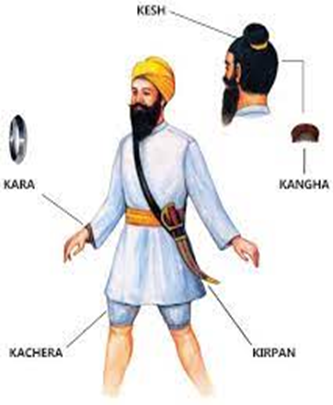
- Guru Gobind Singh’s mother Mata Gujari, and two other sons, Sahibzaada Ajit Singh (18) and Sahibzaada Jujhar Singh (14), gained martyrdom within a week.
- Guru Gobind Singh:
- He is the tenth Sikh Guru (born in Patna, Bihar in 1666).
- The annual celebration of the Guru’s birthday (which falls either in December or January in the Gregorian calendar) is based on the Nanakshahi calendar.
- He became the Sikh guru at the age of nine, following the demise of his father, Guru Tegh Bahadur, the ninth Sikh Guru.
- He Introduced the turban to cover the hair.
- He fought against the Mughals in the battle of Muktsar in 1705.
- Guru Gobind Singh was killed by a Mughal assassin in 1708, a year after the death of Aurangzeb.
- He named Guru Granth Sahib, the religious text of the Khalsas and the Sikhs, as the next Guru.
- His literary contributions include the Jaap Sahib, Benti Chaupai, Amrit Savaiye along with Zafarnama (a letter to Aurangzeb)
Source:
https://indianexpress.com/article/explained/explained-culture/veer-bal-diwas-zorawar-singh-fateh-singh-guru-gobind-singh-sons-8344745/
e HRMS - Edukemy Current Affairs
- Context: Union minister Jitendra Singh is set to launch revamped probity portal and e-HRMS 2.0 portal for central government employees on Sunday.
- E-HRM is the application of IT for HR practices that enable easy interactions between employees and employers.

- This is an online platform that will contain all the details of any employee.
- As the portal will record all the details of the employees, it will be easier for the recruiters or organisations to recruit the person on the basis of their performance. It stores information regarding payroll, employee personal data, performance management, training, recruitment, and strategic orientation.
- E-HRM is, in essence, the devolution of HR functions to management and employees.
- E- HRM costs lower and improves efficiency
- by reducing paperwork and streamlining workflow,
- automating redundant HRM tasks,
- empowering employees, a self-service HRM delivery system,
- keeping the company workflow fully informed about all important HR compliance issues and corporate events,
- enhancing response time of HRM systems, and
- improving time management.
Sources:
https://www.livemint.com/news/india/revamped-probity-e-hrms-portals-to-be-launched-for-central-govt-employees-11671884696029.html
https://www.iedunote.com/e-hrm
Image Source:
https://static.pib.gov.in/WriteReadData/userfiles/English-eHRMS%20brochure.pdf
Benin Bronze - Edukemy Current Affairs
Why in news? Recently, Germany has returned 20 Benin Bronzes that were looted in the 19th century to Nigeria.
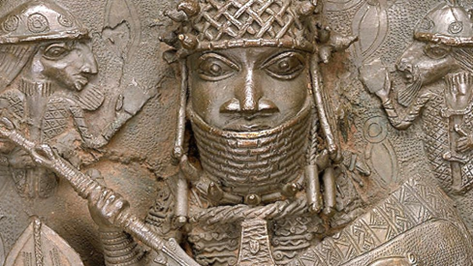 About:
About:
- The Benin Bronzes are a group of over 3,000 sculptures and artworks from the ancient Kingdom of Benin in present-day Nigeria.
- It dates back to at least the 16th century.
- Several of these pieces were specially commissioned for the kings or Obas, and Queen Mothers of the kingdom.
- These artefacts provide insight into the culture of the Benin Kingdom as well as its relationships with neighbouring states.
https://indianexpress.com/article/explained/explained-global/a-short-history-of-looted-benin-bronzes-8339868/
Butterfly survey/Mudumalai Tiger Reserve
Why in news? The First-ever butterfly survey in Mudumalai Tiger Reserve has recorded 175 species.
About:
- The survey aims at assessing the butterfly diversity in the forest areas of the western ghats region, which is vulnerable to climatic changes.
- The survey coincides with the annual butterfly migration in south India from the plains to the Western Ghats areas.
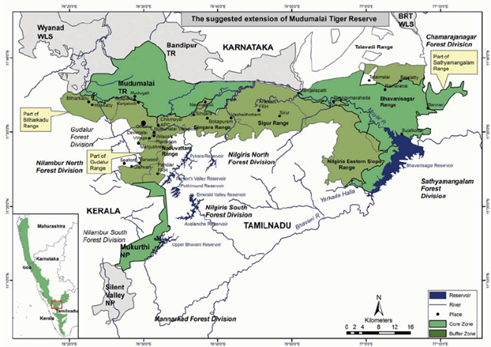
Mudumalai tiger Reserve
- At the tri-junction of three states, namely Karnataka, Kerala, and Tamil Nadu, it is located in the Nilgiris District of Tamil Nadu.
- It has a common boundary with Wayanad Wildlife Sanctuary (Kerala) on the West, and Bandipur Tiger Reserve (Karnataka) on the North.
- 8% of bird species found in India are recorded in Mudumalai.
https://www.thehindu.com/news/national/tamil-nadu/first-ever-butterfly-survey-in-mudumalai-tiger-reserve-records-175-species/article66307648.ece/amp/
Right to Repair - Edukemy Current Affairs
Why in news? Recently, Food and Consumer Affairs Minister launched the right-to-repair portal & new premise of the National Consumer Helpline.
About:

- The Right to Repair refers to government legislation that is intended to allow consumers the ability to repair and modify their own consumer electronic devices.
- The idea originally originated in the USA where the Motor Vehicle Owners' Right to Repair Act 2012, required the manufacturers to provide the necessary documents and information to allow anyone to repair their vehicles.
- The objective is to empower consumers, coordinate trade between the original equipment manufacturers and the third-party buyers and sellers and reduce e-waste.
https://zeenews.india.com/economy/goyal-launches-right-to-repair-portal-new-premise-of-national-consumer-helpline-2553628.html/amp
FTA and Preferential Trade Agreement
Why in news? Stress on non-tariff issues by the developed nations on India is shrinking the time window for free trade agreements (FTAs) with the UK, European Union, and Australia.
About:
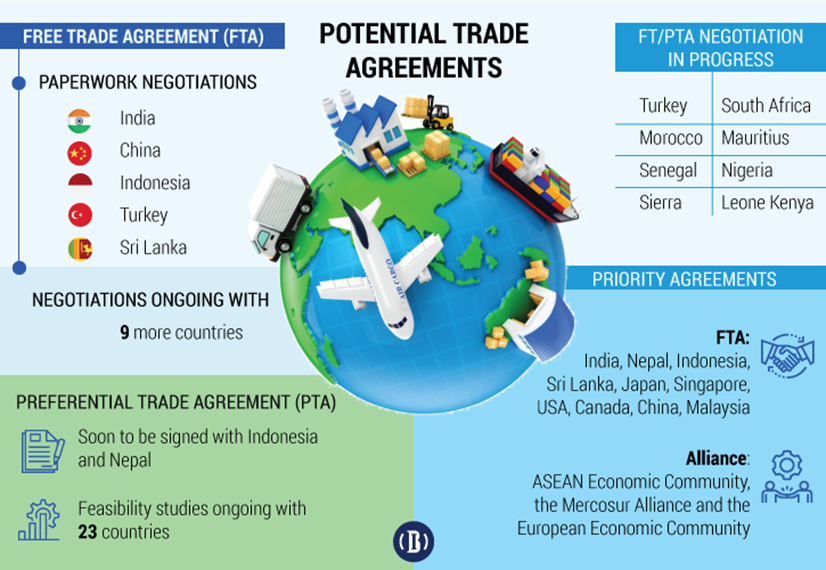
FTA
- A free trade agreement is an agreement in which two or more countries agree to provide preferential trade terms, tariff concession etc. to the partner country.
- Here a negative list of products and services is maintained by the negotiating countries on which the terms of FTA are not applicable hence it is more comprehensive than a preferential trade agreement.
Preferential trade Agreement:
- Two or more partners give preferential right of entry to certain products.
- This is done by reducing duties on an agreed number of tariff lines.
- Here a positive list is maintainede., the list of the products to which the two partners have agreed to provide preferential access.
- Tariff may even be reduced to zero for some products even in a PTA.
https://indianexpress.com/article/business/economy/window-for-ftas-shrinks-as-india-braces-for-set-of-non-tariff-barriers-8343909/lite/
Environmental Impact Assessment (EIA) and its Legal backing
Why in news? Recently, The National Green Tribunal (NGT) said that EIA for some classes of construction projects will result in “diluting” the existing mechanism and “cannot thus be sustained”.
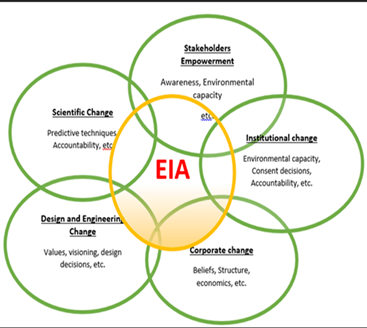
About:
- As per United Nations Environment Programme (UNEP), EIA is a tool used to identify the environmental, social and economic impacts of a project prior to decision-making.
- EIA in India is statutorily backed by the Environment Protection Act, 1986.
Aim:
- To predict environmental impacts at an early stage in project planning and design, find ways and means to reduce adverse impacts, shape projects to suit the local environment and present the predictions and options to decision-makers.
https://www.thehindu.com/news/cities/Delhi/change-in-environmental-impact-assessment-process-cant-be-sustained-ngt/article66302112.ece/amp/
Create in India - Edukemy Current Affairs
Why in news? Recently, The Union Ministry of Information and Broadcasting released the Animation, Visual Effects, Gaming and Comics (AVGC) task force report.
About:

- ‘Create in India’ for India and for the World among key features of Animation, VFX, and Gaming.
- ‘Create in India’ campaign with an exclusive focus on content creation, In India, For India & For World.
- Among key recommendations made by the task force to realize the industry potential and creation of job opportunities in the new-age sector.
- National AVGC-XR Mission with a certain Budget outlay is sought to be created for integrated promotion and growth of the sector, the launch of a ‘Create in India’ campaign with an exclusive focus on content creation — In India, For India and For World.
https://theprint.in/economy/create-in-india-for-india-and-for-world-among-key-features-of-animation-vfx-gaming-comics-task-force-report/1283790/
India's Fuel Strategy Amid Global Energy Crisis: ET
Global Energy Crisis
Exam View: International Energy Agency (IEA), Coal-based thermal power plants, Sustainable Development Goals, Status of India's oil imports and energy security, Major Energy Security Concerns for India, Efforts Governing India's Energy Transition.
In News: The article is based on “How India is filling its fuel tank amid ongoing global energy crisis” published in Economic Times talks about the Global Energy Crisis and the challenges associated with it.
The International Energy Agency (IEA) reports that India's energy demand could increase by more than 3% yearly until 2030 as a result of urbanisation and industrialization at periods when the world is experiencing a worldwide energy crisis.
However, India is still making enormous progress with its efficiency and deployment of renewable energy regulations. Climate change, logistical supply problems, geopolitical unrest (Russia-Ukraine War), and the gradual recovery of the economy following the Covid-19-induced lockdown have all had an impact on India's energy dynamics.
Therefore, one of the pillars of India's energy security should be to accelerate the switch to renewable sources and hasten the end of the dominance of fossil fuels in order to reduce the ongoing risks to energy security.
The status of India's oil imports and energy security:
Major Energy Security Concerns for India:
Common Coal Pool and Price Increase: The conflict between Russia and Ukraine, which caused Europe to focus its attention elsewhere to buy coal from Indonesia, Australia, and South Africa—countries that had previously been major coal suppliers to China and India—further exacerbated the growing demand for coal.
A Rise in Demand Caused by Climate Change: The utilities were unprepared for the exceptional hot wave brought on by climate change in the nation and the significant increase in demand, which reached 201 gigawatts in April 2022, so stocks at the coal-based thermal power plants fell short despite this increase in domestic coal production.
Health Threat: The combustion of conventional energy sources, such as wood, dung, and crop residue, results in indoor air pollution that is bad for people's health.
- In India, household air pollution (HAP) is thought to be the cause of one out of every four premature fatalities.
- 90% of them are women who work in kitchens with insufficient ventilation, near to these fuels.
Import dependence and geopolitical disruptions: In the first half of 2022–2023, India's overall imports climbed by 15% while its bill for importing crude oil increased by 76% to USD 90.3 billion.
Fear of Retail Inflation and Affordability: India performs poorly in terms of the affordability of petrol and diesel despite significant oil subsidies.
- Diesel prices account for 60-70% of India's freight costs. Prices for goods are raised universally as a result of high freight expenses brought on by an increase in diesel prices.
Efforts Governing India's Energy Transition:
Way Forward:
- Energy Planning to Reduce Energy Inequality: To be able to sustain shocks to the entire power generation and supply chain, it is necessary to prepare ahead for rising energy demand and recurrent coal problems.
- Energy security will be essential to achieving sustainable development goals including eradicating hunger, malnutrition, and poverty, and ensuring everyone's well-being.
- The transition to a low-carbon economy and increased energy security could be sped up by supporting renewable energy through women's leadership and empowerment.
- India has to progressively but dramatically diversify its energy production sources, including more renewable energy sources (solar, biogas, etc.) that are cleaner, greener, and more sustainable.
- The utilisation of renewable energy can help create low-carbon development policies and provide job chances for the working people of the nation.
https://economictimes.indiatimes.com/opinion/et-commentary/how-india-is-filling-its-fuel-tank-amid-ongoing-global-energy-crisis/articleshow/96500849.cms?from=mdr
Temple Entry Movement - Edukemy Current Affairs
Background
India has historically seen several temple entry movements due to the presence of a discriminatory caste system. Recently such an incident occurred at a temple in Salem, Tamil Nadu where caste Hindus tried to prevent the entry of Dalits.
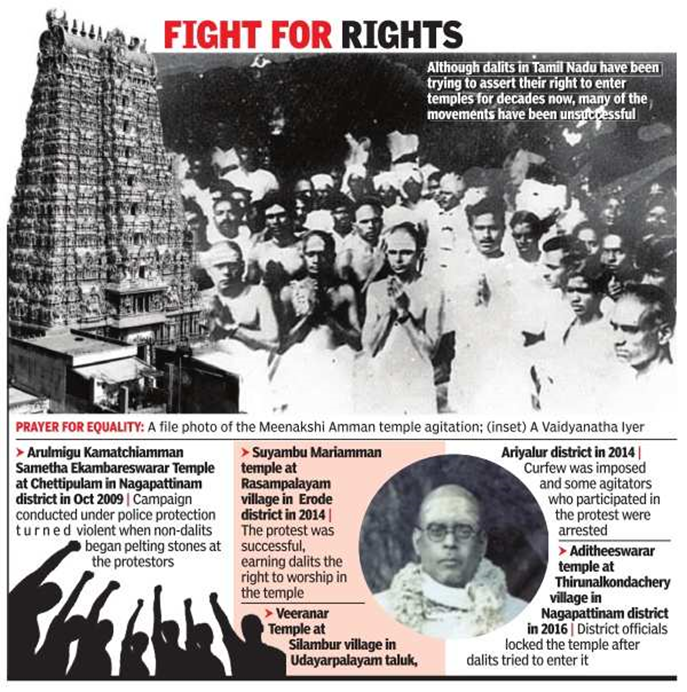
About Temple Entry Movements in India
India has seen several temple entry movements and efforts to annihilate the caste system throughout its history.
- Aravipuram movement: It was a reaction against Brahmanical supremacy and the caste system by Sri. Narayana Guru. He built a temple dedicated to Lord Shiva at Aruvippuram which was against the caste-based restrictions of the time.
- Vaikom Satyagraha: It was a mass movement led by Ramaswamy Periyar that demanded lower caste persons be given the right to use a public path in front of the famous Vaikom temple. It managed to open the roads around the temple for their use.
- Satyagraha in Guruvayur: A Satyagraha by a mix of lowest caste Harijans to the highest caste Namboodiris to allow entry of all castes into temples. Kelappan went fast until death to facilitate temple entry to all.
Persistence of Caste-Based discrimination:
- Article 15 prohibits discrimination against citizens on the basis of race, religion, caste, sex and place of birth to access spaces dedicated to the use of the general public.
- Article 17 also prohibits untouchability. But discrimination in society persists.
- Lakshmi Ranganatha Swami temple in Karnataka is an example where Dalit households are exempted when the idol of the presiding deity is taken out for a procession during the Utsava.
- The upper caste women protested the entry of women belonging to the Holeya community (SC) into the local Hanuman temple in Yadgir, Karnataka.
- Similarly, it took policemen in Hassan, Karnataka for Dalits to enter the temple.
Source:
https://www.thehindu.com/news/national/tamil-nadu/temple-in-salem-sealed-after-caste-hindus-prevent-entry-of-dalits/article66306714.ece/amp/
Share the article
Get Latest Updates on Offers, Event dates, and free Mentorship sessions.

Get in touch with our Expert Academic Counsellors 👋
FAQs
UPSC Daily Current Affairs focuses on learning current events on a daily basis. An aspirant needs to study regular and updated information about current events, news, and relevant topics that are important for UPSC aspirants. It covers national and international affairs, government policies, socio-economic issues, science and technology advancements, and more.
UPSC Daily Current Affairs provides aspirants with a concise and comprehensive overview of the latest happenings and developments across various fields. It helps aspirants stay updated with current affairs and provides them with valuable insights and analysis, which are essential for answering questions in the UPSC examinations. It enhances their knowledge, analytical skills, and ability to connect current affairs with the UPSC syllabus.
UPSC Daily Current Affairs covers a wide range of topics, including politics, economics, science and technology, environment, social issues, governance, international relations, and more. It offers news summaries, in-depth analyses, editorials, opinion pieces, and relevant study materials. It also provides practice questions and quizzes to help aspirants test their understanding of current affairs.
Edukemy's UPSC Daily Current Affairs can be accessed through:
- UPSC Daily Current Affairs can be accessed through Current Affairs tab at the top of the Main Page of Edukemy.
- Edukemy Mobile app: The Daily Current Affairs can also be access through Edukemy Mobile App.
- Social media: Follow Edukemy’s official social media accounts or pages that provide UPSC Daily Current Affairs updates, including Facebook, Twitter, or Telegram channels.

